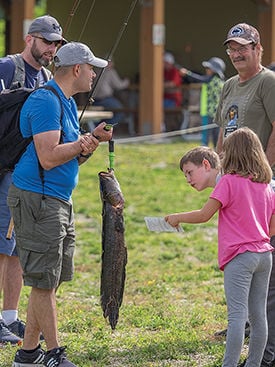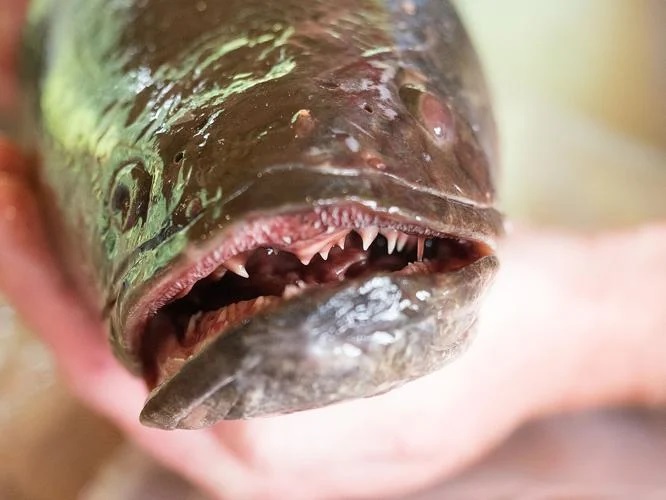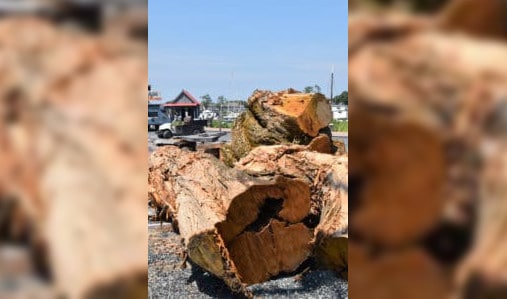What’s in a name? A couple of Southern Maryland lawmakers want to boost the catch and consumption of the northern snakehead, one of the Chesapeake Bay’s more troublesome invasive fish, by giving it a new, less off-putting moniker. If only it were that easy.
“When you go out to eat dinner with your family, who’s going to order a snakehead fillet, right?” asked Sen. Jack Bailey, a Republican who represents St. Mary’s and a portion of Calvert counties. “It just doesn’t happen.”
Bailey and his House colleague, Del. Todd Morgan, also a Republican from St. Mary’s County, introduced companion bills to rename the northern snakehead as the “Patuxent Fish.”
Native to parts of Asia and Russia, northern snakeheads were discovered in 2002 in a pond in Crofton, Maryland, not far from the Little Patuxent River. Authorities promptly poisoned and drained the pond, but apparently too late to keep the fish from spreading. Two years later, the fish turned up in the Potomac River near Woodbridge, Virginia. Since then, they have made their way throughout much of the Bay watershed, including the Susquehanna River and the Eastern Shore.
Snakeheads already have a variety of nicknames, the most notorious being “Frankenfish,” inspired by their toothy appearance, voracious appetites for other fish and crustaceans, and their somewhat exaggerated ability to survive out of water and “walk” over land.
As Bailey explained Jan. 23 to members of the Senate’s Education, Energy and Environment Committee, many people believe the only way to limit the harm caused by snakeheads to other fisheries is to harvest and eat more of them. Maryland and other Bay states have been encouraging anglers for years to catch and eat or at least kill as many snakeheads as they can, and they have placed no limit on the commercial harvests.
But the snakelike name is unappetizing, he said, and with limited consumer demand, the Maryland harvest is meagre, far less than that for blue catfish, the Bay’s other invasive predator. So Bailey and Morgan suggested doing what clever marketers have done for years to make fish with nasty-sounding names more palatable: give it a new handle for listing on restaurant menus and in seafood markets.
The only problem was that advocates for the Patuxent River vigorously objected to being associated with a fish causing ecological havoc.

Patuxent Riverkeeper Fred Tutman began circulating a petition warning that naming the snakehead for the river he’s sworn to protect “potentially stigmatizes” it in the public’s mind. His petition says that people might assume there’s something wrong with the river or the other fish, crabs and oysters that come from it.
Rachel Dean, secretary of the Calvert County Watermen’s Association, told the committee she bowfishes for snakeheads herself and agreed with the intent of Bailey’s bill but not the name.
“It’s still difficult to get anyone to eat a fish called a snake,” she said. “That is unfortunate because snakehead ranks just behind white perch as the best tasting fish in the Chesapeake Bay.”
Dean called the renaming bill a “noble cause” but said Patuxent Fish “doesn’t have a ring to it.” She also didn’t want the Patuxent to be known for snakeheads, so she puckishly proposed a “friendly amendment” to rename the snakehead the “Bailey fish.”
“While I am by no means saying Senator Bailey shares the slimy, predatory characteristics of the fish,” she said, amid laughter from those in the hearing room, “[and] by the way, I think they’re a pretty good-looking fish — I do believe his contributions to conservation of natural resources … warrant a fish be named after him.”
“Besides,” she said, “I think we can get behind fried Bailey, baked Bailey, Bailey tacos, Bailey nuggets and Bailey bites.”
Bailey said the name Patuxent Fish came from a group of local college students he’d asked for help in renaming snakeheads and thought they “did a great job.” But even before Dean’s ribbing, he said he was open to whatever the committee wanted to do, and “if you all find a better name, I’m fine with it. “
Tutman suggested popularizing the snakehead’s scientific species name, Channa argus.
“Pass the Channa fish, would you?” he rehearsed.
By the time Morgan appeared on Feb. 2 before the House Environment and Transportation Committee to testify for his version of the snakehead bill, he had already retreated from naming it for the Patuxent.
Instead, he suggested amending the bill to call northern snakehead “Chesapeake Channa.”
“Chesapeake to reflect the Bay,” Morgan explained, “Channa to reflect its native [scientific] name … We want to make it so people want to go to a restaurant and pay good money for an exotic fish. Watermen are happy, restaurants are happy, people are happy.”
Renaming the snakehead as Chesapeake Channa even drew support from the Moore administration. But first, Rachel Jones, government affairs director for the Maryland Department of Agriculture, offered one more offbeat suggestion. She said her boss, Secretary Kevin Atticks, would support calling it the “Joefish” after his uncle, Joe Gillespie, who was the first person to hook a snakehead in the Crofton pond more than two decades ago.
This story first appeared at bayjournal.com on Feb. 5, 2024.




